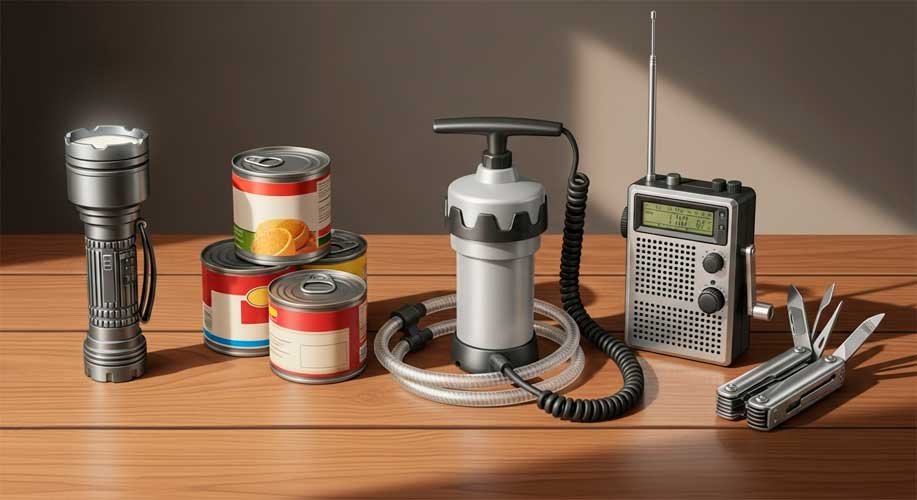We live surrounded by comfort — electricity, Wi-Fi, online payments, and food delivery. But what happens when all of that disappears? How do you survive when technology fails?
This guide teaches the essential survival skills every modern person (and family) should know — how to stay calm, safe, and self-sufficient when technology goes dark.
Why You Should Prepare for a Tech Blackout
Modern life depends entirely on the invisible power grid and global data networks.
From online banking to the food in your refrigerator, everything runs on electricity.
But what would happen if that power suddenly vanished for days… or weeks?
- No light. No internet. No way to pay or communicate.
- No gas for cooking. Only canned food and cold water.
- No ATM or bank app. Digital money becomes useless.
This isn’t science fiction — regional blackouts, cyberattacks, and power failures are more common than ever.
The good news? You don’t need to become a survivalist to be ready — just someone who knows the basics.
The Core Survival Skills Everyone Should Know

Fire and Light
When darkness hits, light becomes comfort and safety.
- Keep candles, matches, and lighters in a waterproof box.
- Invest in solar lanterns or rechargeable flashlights (they’re safe for kids).
- Learn to start a small fire safely — outdoors only, and always with water nearby.
Water
Water is priority #1.
- Store 4 liters per person per day for at least three days.
- Learn basic filtration using cloth, charcoal, and boiling.
- Have a portable water filter or purification tablets on hand.
Food
You don’t need a bunker — just a plan.
- Stock non-perishables: rice, beans, oats, canned goods, peanut butter.
- Rotate supplies every 6 months.
- Learn “no-cook” meals you can make without electricity.
Shelter and Warmth
If you lose heating, insulation matters.
- Keep thermal blankets, duct tape, and candles.
- Block drafts with towels or clothing.
- If safe, stay in one room to conserve warmth.
Must-Have Tools and Gear for Every Home
A small, well-chosen kit can make the difference between chaos and control:
| Category | Item | Why It Matters |
|---|---|---|
| Power | Solar charger / small generator | Keep phones and radios running |
| Communication | Hand-crank or solar radio | Get emergency updates |
| Tools | Multitool, duct tape, pocket knife | Fix or improvise anything |
| Safety | First-aid kit, gloves, masks | Handle injuries or debris |
| Light | LED flashlight, solar lanterns | Safer than candles |
| Documents | USB backup + printed IDs | For offline access to essentials |
Tip: You can find affordable starter kits on Amazon
Practice Survival as a Family Activity

Preparedness doesn’t have to be scary. It can be fun, educational, and empowering.
- Hold a “blackout night” — turn off all power and see how your family adapts.
- Teach kids to find safe light sources or boil water.
- Make it a challenge: “Can we cook dinner without using electricity?”
These moments build problem-solving and calm under pressure — priceless in any emergency.
Books and Resources Worth Having
Even when the internet dies, knowledge shouldn’t. Keep a few physical guides at home:
- SAS Survival Handbook — John Wiseman
- The Prepper’s Survival Guide — J. Cobb
- First Aid Manual — British Red Cross
- Field Notes on Preparedness — small printable checklists
Offline tip: Download first-aid and map apps that work without internet (e.g., Maps.me, First Aid by IFRC).
Final Thoughts: A Smart Backup Plan for a Digital World
Preparing for a tech blackout isn’t paranoia — it’s maturity.
It’s the awareness that our comfort depends on fragile systems, and real resilience starts with knowledge.
When technology collapses, the best tool you have is your ability to stay calm, adapt, and act.
So learn the basics, stock the essentials, and teach them to your children.
Because one day, knowing how to live without technology might be the most modern skill of all.
FAQs
Q1. What’s the first thing to do during a power outage?
Secure light and water. Use flashlights instead of candles to avoid fire hazards.
Q2. How can I prepare my family for an emergency?
Create a 72-hour kit, plan meeting points, and practice short “blackout drills.”
Q3. What items should every home have for survival?
Water filters, canned food, flashlight, first-aid kit, solar power bank, radio.
This post contains affiliate links. As an Amazon Associate, we may earn commissions from qualifying purchases.

